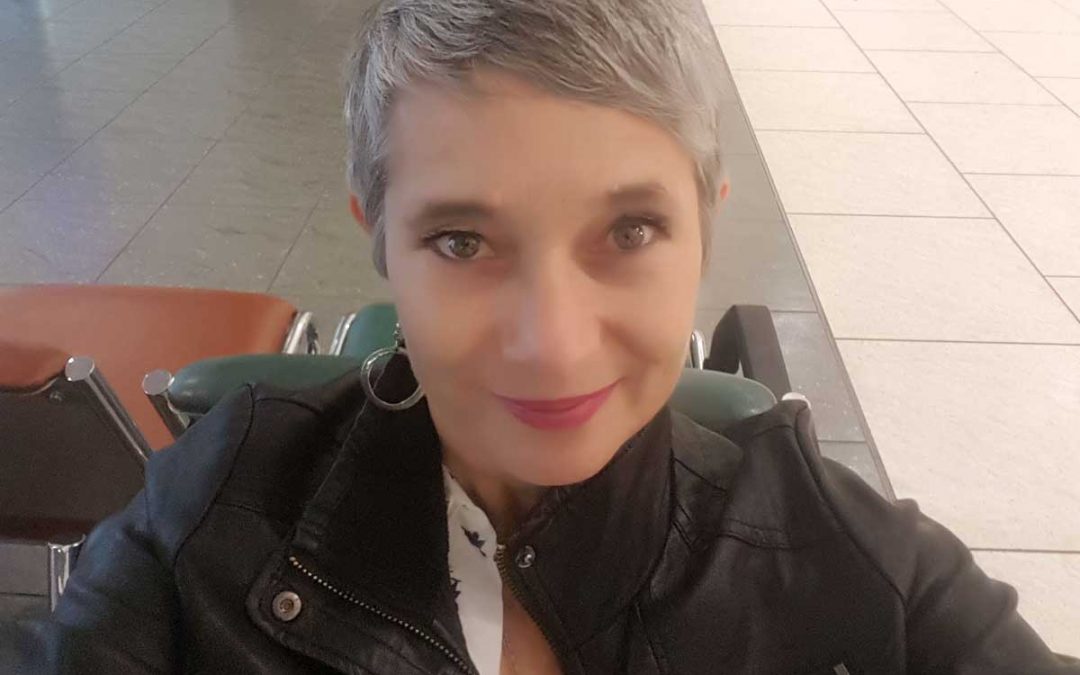
by MotherWit | Sep 12, 2018 | Uncategorized
Early this May I finally took the grey hair plunge. I cut off all of my bottle-brunette hair down to its vulnerable salt and pepper roots. Not only was it a radical palette change, but the crowning glory that had cascaded wavily past my shoulders was whittled to the shortest of pixie cuts one can have without actually shaving one’s head.
At the age of 30, when hairdressers were beginning to try to convince me to extinguish the growing bursts of silver in my long dark hair, I felt rebellious. “No way!” I said. I had birthed three children by the age of 29, and felt I had earned each one of those greys. They were my badges of wisdom, my commitment to nonconformity. They were political, damn it! But by the time I was 35 and pregnant with my fourth child, I began getting increasingly uncomfortable with how I was feeling an “ageing” woman. An OB had suggested an amniocentesis because of my “advanced maternal age”. Bouncing back to a pre-baby body, which had happened without so much as a thought after my first two kids were born, became an insurmountable task after my third and fourth. I felt that instead of illuminating my hard gleaned maternal wisdom, the grey hair was now a testament to the unconscionable tarnishing of my youth.
Once my fourth baby was born, I switched from doing the occasional dark henna to semi-permanent dyeing. There came a point when the semi-permanent dye was no longer providing enough coverage for my bright, wiery silver strands. Despite the promise I had made to myself to refrain from the monthly “chasing of the white stripe” ritual that millions of women succumb to in the name of maintaining the comfortable front of youthfulness, I bit the bullet and turned to permanent dye. The cheap kind.
I would hear friends in their late 30’s, who had as much grey in their hair as I had had in my 20’s, extolling the badassery of their choice to not dye. It’s easy to love your grey when it’s a cool novelty. “Just wait until people begin thinking you’re older than you are,,” I’d say to myself silently in response to their self-satisfaction. This was admittedly unkind of me, as women can often feel towards each other when internalized youth-favouring beauty standards are triggered and the shame of not living up raises its ugly head.
In 2012, one day after my 43rd birthday, I received the devastating diagnosis of advanced cervical cancer. A hysterectomy wasn’t going to be the cure for me as it often is, luckily, for women whose cervical cancers are not as invasive. Mine was too far gone. I was informed I had to undergo six weeks of daily radiation and weekly chemotherapy as well as some other intense procedures I will refrain from freaking anyone out over.
A friend of mine who’s an OB/GYN happened to be in the hospital on the day of my diagnosis. He walked into the shared room and closed the curtains around us for privacy. One of the first questions I asked him after, “am I going to die?” was NOT, “how will the quality of my life be affected?” nor “can you tell me more about how this crazy fast-tracked menopause is going to go down with all these treatments?” I didn’t even ask him to give me a hug. No. I asked, “am I going to lose my hair?” He smiled and responded as if it never failed to surprise him, “this is among the first questions almost all women ask when faced with the prospect of chemo.” Oh, how vulnerable we are when our identities, so deeply tied in with how we perceive our looks, are threatened.
 In preparation for chemo, I decided to cut my near shoulder length mane short. I had been informed that with the type of chemo I was getting hair loss was probably not going to be much of an issue, though it could get thin, brittle, or patchy. I wasn’t interested in thin, brittle, or patchy. Before my treatment began, some of my beloved friends took me to a salon and held my hands while I succumbed to a pixie cut.
In preparation for chemo, I decided to cut my near shoulder length mane short. I had been informed that with the type of chemo I was getting hair loss was probably not going to be much of an issue, though it could get thin, brittle, or patchy. I wasn’t interested in thin, brittle, or patchy. Before my treatment began, some of my beloved friends took me to a salon and held my hands while I succumbed to a pixie cut.
It was sad, but I felt braver facing cancer treatments that way. The ritual of cutting my hair off was symbolic of shedding all of the patterns I needed to let go of to heal. Others find different symbols to support their healing journey, of course, but for me the cutting of my hair was not as much about vanity as it was about fostering release, resolve, and courage. Even so, there was indeed a modicum of vanity involved because you can bet that before getting that super short hair cut I dyed my hair to the hilt with no greys showing.
That vanity didn’t last long once the treatments started happening. The intense pain, hours spend in the hospital waiting for and getting treatment daily, complications, sickness, being constantly high on narcotics and 30 pounds of weight loss from my small frame really put things into perspective. Until, of course, I got well and started to care about my looks again. The things that had seemed absolutely pointless to worry about in the face of cancer, pain, and fear of death started beckoning with the gleam of importance again.
The return of some vanity was a sign that I was back in the land of the living. I felt good again, and wanted to look as good as I could too. I do believe that caring about our appearance to a reasonable degree is a sign of wellbeing. I grew my hair long again and simply disassociated from the shocking amount of silver that could be seen shining close to my scalp a mere two weeks after a fresh dye job.
About three years after healing from cancer, I started to think, “hmmmm. Maybe it’s time to let my hair be grey.” I’m not sure what precipitated this thought, but I felt on the verge of a major transformation that a head of frosted hair would lend gravitas to. I would still, however, feel quite defensive when people responded, “do it! It’s liberating, it’s flipping the bird to the beauty industry, it’s cheaper, it’s healthier, it’s authentic, smash the patriarchy!” I felt defensive because while cancer and healing from it had been such an insight laden journey of growth for me, there were things I had lost too. Though I had personally never planned on having a baby in my early to mid-forties (as awesome as it is that many people do), the fact that the cessation of my cycles was provoked before its natural schedule put me in the ranks of post-menopausal women.
I was worried that more than usual grey hair for a forty-something year old and menopausal changes would make me present as a prematurely aged woman. Having been through cancer and survived you’d think it wouldn’t have mattered, that facing my own mortality would have given me a pass from the drive to subjugate myself to our weird, culturally generated ideas of what looking good means. But it did matter. Now don’t get me wrong. I see so much beauty in the lines, soft faces, and silvered hair of mature women. I just didn’t want to be one of them yet as I was still young-ish, despite menopause and grey roots. Yet something in me was beginning to whisper that it was time to accept the fact that a type of crone, or at least a baby version of one, was crying to be born and seen.
I began observing the hair of women in their mid 40’s and older. I was generally able to tell who dyed it at home out of a bottle or who likely had time and money to go to a salon. It is AMAZING how many visible grey roots there are out there when you look. Around 75% of North American women who are going grey dye their hair apparently. Because a) it needs to be dyed regularly every few weeks to hide the fact that you’re dyeing and b) many women simply don’t have the time and/or money to do it as regularly as it needs to be done to keep it fresh. the fact that so many of us are trying to cheat the natural softening of age is TOTALLY OBVIOUS! Most people, especially if they’re taller than we and able to look down at our roots, (which in my case is the vast majority of adults) know we’re “fudging” Nature’s designs upon our locks as evidenced by the telltale silver strip at our crowns.
One day, sitting in my stylist’s chair correcting a home dyeing mistake that had left everything about my hair flat black except for two inches of carrot orange at the roots, I began to wonder if it was worth it. The mistake was so drastic that it had to be taken care of, at a great financial and chemical cost, gradually over a few visits. I sat there under the bright lights and caught a glimpse of the the brilliant fairy flecks of silver just beginning to peek out from my hair part, sparkling beguilingly like the precious flashes of fireflies on a summer night. “I am kind of thinking the silver looks pretty,” I said shyly to my thirty year old stylist.
“I am NOT letting you go grey!” she exclaimed with a quick ferocity. “I will tell you when it’s time. It’s not all silver yet. Salt and pepper hair is ugly. Here’s the bottom line: do you want to look like you’re in your 30’s or in your 60’s? Because you WILL look way older than your age if you let your hair be grey.” Now please don’t get me wrong. My stylist is a lovely woman. Truly. We go way back. But as a beauty industry representative who is also in the glorious throes of enjoying luscious silver thread-free locks, she was obviously deeply triggered by my flight of fancy, and felt it was her duty to shield me from being judged as “old”. She had been tending to me as a youngish looking mother of four. She was just trying to protect my image, bless her. Or at least her internalized image of how she thought a woman my age should choose to look if she could.
I began to see how deep and insidious this attachment to image was. When I mentioned I was thinking of going grey I received a wide variety of opinions. “Do it!!!!” was definitely one of them by the women who felt liberated by the end of their own dyeing journeys. Young women who found the idea of chemically torturing their gorgeous hair into the state of “granny grey” I had been trying to cover up for years thought the idea was super cool. However, a lot of responses were, “but Lesley, you are so youthful. I can’t see you with grey hair.” I liked the super honest responses. “You ARE getting older, and the darkness of your hair is starting to make your face look harsh.” It was true. The dark hair was weighing me down.
I became pretty caught up in the agonizing vacillation about something that seemed on the surface to be so frivolous. I hated feeling so trapped in the game of vanity. My husband was wise enough to refrain from giving too many opinions about it, though I knew he had some concerns about having a suddenly shorn, grey haired, potentially elderly looking wife. It is not that he thinks elderly women are unattractive, but he had unspoken thoughts about how it might feel if I did, indeed, appear more elderly than I actually was. He himself has maybe two whole grey hairs on his head and we’re the same age. My kids became increasingly bored with my “should I or shouldn’t I?” Facebook posts. “It’s just hair!” they exclaimed. “It grows, you can colour it if you don’t like it. It doesn’t mean anything. MUM!! Who cares?”
The decision was made before my conscious mind knew it. I simply continued to put off going to my regular hair trim and root touch up appointments. Frankly my stylist scares me a little. My roots became screamingly obvious. I was afraid she would “tut tut” me for having waited so long to tend to them. And then.. I began to like them. I mean really really like them. At first I wore the “headband of shame” constantly to cover up the evidence of age and imperfection because I thought other people would be ashamed for me. But it didn’t last long. My signature teeny bangs grew out and I flipped them back so my roots showed more. I started feeling quite proud of them. But it is one thing to have nifty roots you flash flirtily and another to cut off a mane of long dark hair that has been part of your identify for years.
But one day I just knew. It had to happen. Before booking the appointment (not with my stylist) I became a bit obsessed with how I was going to dress myself and what colours would look good on me with “cooled” hair. I doubted myself, and thought I had to maybe switch to clear, bright colours I’m not generally fond of, or avoid wearing black like the plague so as not to look sallow and washed out. There is a lot of bullshit on the internet that suggests fair-ish Caucasian women with warm undertones to their skin like I have look the worst with grey hair. Then it hit me: does anyone ever try to feed that crap to men? Did anyone ever tell George Clooney his hair clashed with his face? No! He is upheld as a “silver fox” (rightfully so). I decided I would wear whatever the heck I liked. So I booked my appointment, slathered on bright lipstick, grabbed a friend, and off I went back to the salon that had held me so kindly when I got my pre-chemo shearing five years earlier.
Now here I am, mowed down to the silver quick. The process itself was painless, but there is always that horrible “reveal” moment you must do over and over again when you meet with someone you know who witnesses you looking radically different from how they last saw you. I decided to get most of it over with on Facebook by posting a “before….” and then an “AFTER!” photo. 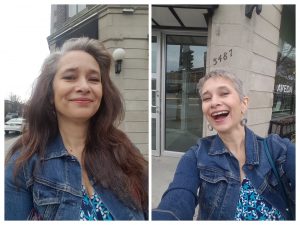
The weirdest and most unexpected thing happened. I have never in my years on social media received as many “likes” and glowing comments as I did revealing my “after” photo. And I have made some pretty awesome posts in my life (some in which I have looked way cuter, too)! I have done some things I am quite proud of, if I do say so myself. I have trained hundreds of women to be doulas. I have contributed heavily to the pioneering of doula support in my city. I am one of the few doulas in North America who has been invited to guest lecture in the medical program at a major university as part of their curriculum on effective support for birthing families. I get to help shift the difficult parts of our birth and mothering culture from the inside out. I have built a family and a business and a brand. I have birthed four spectacular humans and have been married to my dearest friend for 27 years. I am an ordained interspiritual minister and coach who provides insightful support for extraordinary transformation Even my posts about being a cancer survivor had not been met with such wild enthusiasm.
Does this mean that as a society we’re so very shallow that the silver pixie cut of a woman of a certain age elicits more “Oh my God, you’re awesome!” than “Yay, I have no more cancer!”? No, I don’t think it does. What it makes me think is that it’s NOT “just” about hair. Except for a few close male friends, the hundreds of responses I got were from women telling me I looked fabulous. What I think resonated among the women who commented was a respect, whether they liked the idea of grey hair for themselves or not, for a wee act of rebellion. They saw an act of silver disobedience.
Now, I’ve seen a lot of courage in my life. I’ve been witnessing childbirth for a quarter of a century. I have been with parents taking their baby off life support or having to make very difficult decisions in high risk pregnancies. I have worked with people who are at the end of their lives and are facing death with unfathomable grace. I have witnessed women kicking addictions and getting out of abusive relationships. I am asked to create ceremonies for people confirming their true genders and re-naming themselves to the public. These things take real courage.
Getting a haircut down to the natural roots ain’t that brave. And yet it resonates so deeply with so many in spite of all the wild and wonderful things women are capable of. In a world where age tends to be fought tooth and nail as evidenced by all the money and pain we sacrifice upon the altar of the western standards of beauty, we sometimes yearn for a different feeling, a different story from the droves of young women who claim to not want babies because it will “wreck” their bodies, or from the tales of war against the white hair stripe. While the stories will not end until circumstances strip us of the caring about measuring up to “standards” (heck, even my 98 year old Oma doesn’t want to be seen before putting on her green eyeshadow every morning) there are moments we feel tired with the burden of upholding them.
When some random woman decides to bust a move to lay down her fight against the grey “ravages” of the clock because she’s tired of it, sometimes…just sometimes (if there’s not been a major catastrophe in the world that day and there’s nothing good on tv) there’s a breakout standing ovation. And it’s not because she’s “real” brave, like in the fireman brave kind of sense. It’s because for one shining moment she is noticed choosing to release a bit of a falsehood she’s been keeping. She is witnessed claiming an identity she still fears. She is seen embracing that strange phase between “mother” and “crone”, that less talked about time in a woman’s life when she’s not quite elderly yet (when a silver crown seems more acceptable), but is not exactly brimming with youth, either. She is upheld digging down into her audacity, despite her anxiety about getting and looking old, to own it.
So with trembling heart, shining eyes and silver hair, I take up the mantle of this new eldership-without-apology and invite all you women to love yourselves. Right. Fucking. Now. Exactly how you are. Keep on dyeing your hair if that makes you feel sexy. You’ll know when you want to quit if ever, and it’s fine if you never do. You’re gorgeous. Let it be wild and grey if you’d rather. Throw on a crop top and low rise jeans with your crepe-y, stretch marked mama belly and Cesarean scar sticking out proudly. Wear blue eyeshadow up to your un-plucked brows. Let your hair frizz BIG. Get butt cheek implants. Wear loud lipstick you love even if it makes your teeth look yellow. Inject fillers into your naso-labial folds if you like. Let your holy breasts sag to your belly button. Fill your face with holes and weird hardware. It doesn’t really matter. It doesn’t matter because we KNOW the standards of beauty and the way we participate with them are only illusion. It’s all just made up. It’s a theatre and we’re all just putting on costumes. May you, Beloveds, love the costumes you put your fine selves n. It is the owning of your finery, no matter what it is, that makes you beautiful.
When a whole bunch of women doing different things to achieve their own sense of “damn, I’m fine” stand for another woman to applaud her choice to go grey, or stand for a woman in cancer treatment stepping out in a great wig (or another who chooses to bear her shining scalp), or applaud a friend getting the breast implants that make her feel amazing about herself, or congratulate a sister who gets a Botox injection because it brings ease to her aging anxieties and makes her feel good, or clap for someone who feels like a boss in her mom jeans and oversized sweatshirts with cats on them, wool socks and clogs…something unspeakably wonderful happens: we override the unkindness and competition we’re programmed to feel towards each other in order to feed the beast of beauty capitalism. We jump off the beast for a moment, give it a kick in its horrible underbelly before going back to the game, to celebrate together.
In each ovation we give, we see more deeply into each other as we are in our true magnificence that outer looks do not touch. We connect through the simple act of honouring someone owning her own brand of beauty. We accept and respect each other for personal choice, even if we wouldn’t choose the same thing in a million years.
Even though we go back to living in the illusions of our chosen costumery, whether in support or in rebellion of the beast, we know deep down the impetus for so many women to “like” a Facebook post about grey hair isn’t just about hair. In the kindness shared, we experience the most beautiful beauty of all; the beauty of love and honour unfettered by condition. And we know it is what real freedom feels like.
Love Lesley
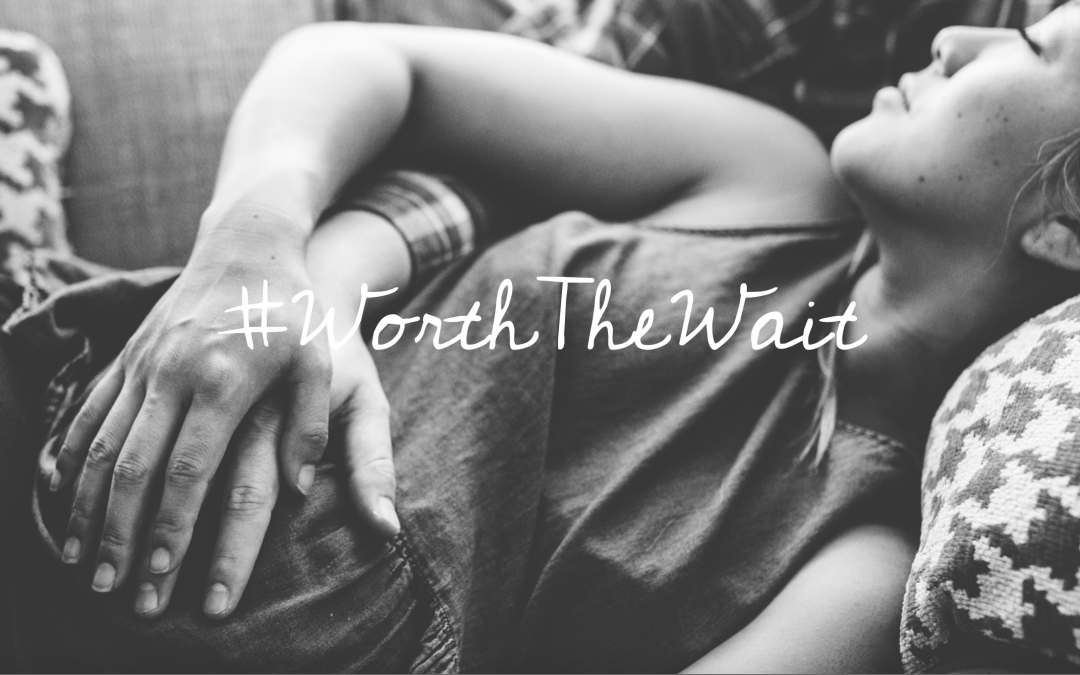
by Katie Tait | Jul 22, 2018 | Uncategorized
This powerful blog captures the rollercoaster of fertility treatment beautifully and in an oh-so-raw, real way. Photographer Amanda Naor chronicles her journey through infertility to parenthood in this series of posts capturing the full range of emotions through her vulnerable photos and words. As you read you will feel as if you are by her side, as she experiences the all-encompassing highs and lows of an IVF cycle
“the infertility journey is such an incredible emotional rollercoaster. it feels isolating. it feels unfair. it feels like mother nature and your body are betraying you. it is expensive. it is painful. it is full of fear but it is so, SO common and no one talks about it. “- Amanda Naor
.

“achievement unlocked: giiiiiaaaant needle into butt. internet achievement unlocked: post photo of your hiney for all the world to see.” -Amanda Naor
Have you found yourself one of the 1 in 6 Canadian couples or women who struggle to conceive? If so, this blog will resonate with you if you have already been on this journey, and will inform and educate you if you have yet to start treatment, or if you know someone who is. Infertility is that unseen affliction which many suffer in silence from.
Even if this is not your personal experience, many of us will unwittingly have family, friends, colleagues or neighbours who are going through what Amanda depicts with such candour here. Amanda`s story shines a light on what making a baby is like for the 1 in 6, in a raw, unflinching way.

“I’m not sure there is anything more beautiful and more bittersweet than being in the infertility community. I have never felt so instantaneously connected to strangers. I have never felt so supported, encouraged, and uplifted by women” – Amanda Naor
Amanda explores not only the fragility and triggers of not being able to conceive but also the guilt and depression that can arise after successful IVF. Having made close connections within the infertility community on forums and websites, Amanda describes how she felt as if she was betraying her new found friends when she finally did conceive, and the accompanying feelings of isolation that this brought.
Amanda also bravely speaks about something rarely discussed or even acknowledged by those who experience successful fertility treatments – post conception depression. After struggling to conceive for so long, once you do, its all a bed of roses once it does happen, right? Not always.
Acknowledging the potential for not-so-positive feelings after conception has a huge impact on how those who go through treatment successfully continue within their pregnancies and parenting journeys. Many who fall pregnant after experiencing fertility issues may feel that they cant acknowledge a difficult pregnancy or postpartum depression, as this may feel especially taboo. In this way, Amanda tackles and addresses this difficult topic, bringing it to the surface and in doing so, seeking to normalize these complex emotions.

“A few days after my husband and I heard our baby’s heartbeat for the first time, I found myself googling “depression after successful IVF”. I never would have imagined this would be how I was feeling. but here I was….so unbelievably grateful, but yet so very sad and numb.” – Amanda Naor
At MotherWit Doula Care in Montreal we host a free monthly fertility peer to peer support group every 3rd Tuesday of the month from 7-9pm. The group seeks to provide a safe space for anyone struggling with fertility issues to come, share their stories, and find community. Whatever stage of this path you are on, we welcome you. Come and join us.
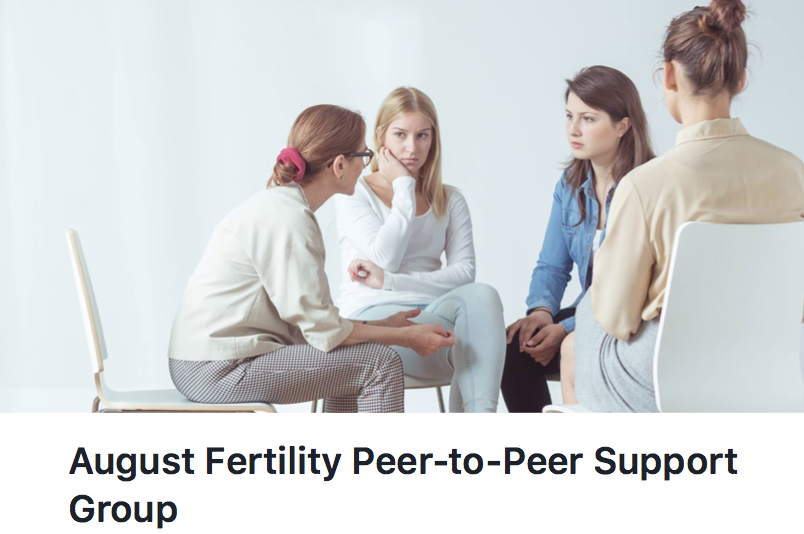
Please share widely. We need to break down barriers and share what the journey to parenthood looks like for some families.
#worththewait #lovehopeandalittlebitofscience #infertility #1in6 #IVF #fertility #motherwitdoulacare

by MotherWit | Jun 29, 2018 | Uncategorized
Has trying become trying? When pregnancy just isn’t happening…one doula’s foray in Fertility (or the lack of it)
If you clicked on this post, then it’s probably because the title resonates with you, and you know this feeling. Maybe it’s been a few months for you, or maybe a few years. Or maybe longer. Maybe your efforts have been successful and you’ve finally had your precious baby(ies). Or maybe not. Either way, you are not alone. Its reported that 16% or 1 in 6 of Canadian couples suffers from a fertility issue, either medically diagnosed or not. If you’ve unwittingly found yourself in this percentage group, a) I’m sorry, and b) welcome! You’ve found your people.
Because we are a people. We are the frantic underwear checking people, who monitor our own secretions for any changes that mean `it’s GO time`. We are the people who are dropping $20 on those devices-of-the-devil that line the pharma industry’s pockets (read, ovulation tests), frantically peeing on said device and desperately looking for that smiley face or pink line (or 2!) that signals `the egg is about to drop!`, as if we are hens in a henhouse. We are the people who fiddle about with thermometers every morning, looking for variations in our basal body temperatures, another indicator that it’s time to take your partner by the hand, etc etc – you know where I’m going here. (and no I’m not alluding to doing a barn dance).
It’s a certain select group who find themselves taking just about every supplement under the sun, following all kinds of complementary therapies that they`d previously thought were the domain of New Age hippies, and doing all kinds of fitness and wellness regimes that they would`ve never previously considered, in the hope that they might just make them feel relaxed (or healthy!) enough to conceive. Or that have found themselves taking Robitussin (you! Yes, you!) in the hope that it will thin out your body mucus. And still, even after all of our best efforts, good old Aunt Flo still shows up like an unwanted ex at a wedding, like clockwork every month, reminding us once again (as if the media doesn’t do a good enough job of it already) that our bodies have failed us once again in what we`re told by society from a young age is one of our main goals – in fact, almost our raison d’etre as women – becoming a mother.
My own fertility journey began some 10 years ago. Having waited what we considered a respectable amount of time in terms of having `us time` after our wedding, myself and my husband proudly told all and sundry that we were about to start trying. BIG mistake. Having been aware of my own mothers struggles to have children (albeit due to a different issue than the one I would later discover of my own), I was prepared for things to take a while. In my Generation-X mindset, `a while`equated to a maximum of 6 months. I had no idea at that stage what being patient really meant. I was about to learn a hard lesson.
One of my closest friends started trying around the same time as me. 3 months later she was pregnant. We later joked that it took me pretty much the same amount of time to conceive in years that it took her in months. `Take your time and savour this precious time of no responsibility whilst you can `, I kept reminding myself. ‘It will happen`. However, with each passing month, I became increasingly anxious. Id say my anxiety probably peaked at about 9 months of trying to conceive, when I really started scouring the internet and any available book I could get my hands on, eager to see if there was any trick that I was missing. I went to my family doctor, who referred me for initial blood work to check my hormone levels, all of which came back within the normal range. Later I would go for highly uncomfortable invasive tests, which also came back with results that were supposed to reassure me that, yes, everything was fine, it was just taking a little longer for us. My poor husband of course played his part, and did his tests, which, apparently, are pretty similar to how its portrayed in the movies. I even splashed out on a trip to an exclusive Harley Street based `Gynaecologist to the stars`, who, after taking $1000 of my hard earned money, sent me off telling me everything was fine – I just needed to loosen up, chill out, drink more wine and cook my man a steak on a Friday night before my next effort to conceive. Oh – if only it was that simple! We would have had a mini Army by that point if it had been that simple, buddy!
More time passed, and one by one all my friends and colleagues became pregnant (or so it seemed. Im sure if I really think about it, not everyone I know was conceiving, but its funny how you perceive things when you’re so consumed by something). I began to feel increasingly isolated. I was convinced that people were keeping their own happy news of conception success from me because they knew we were trying and not succeeding, and indeed I was right in some cases. One of my good friends even didn’t invite me to her son’s birthday party, as she wanted to spare me the awkwardness of choosing whether or not to go. I became to rely increasingly on my single and childless-by-choice friends (most of whom have subsequently had kids, incidentally), and started to avoid family gatherings because I couldn’t bear answering questions as to why I wasn’t drinking. No, it wasn’t for the reason we all wished it was for. More to do with the fact that I was trying to lead the healthier lifestyle Id convinced myself was the key to fertility.
I’m sure this anxiety around social gatherings for fear of avoiding well-meaning (but insensitive) questions from Great Aunt Vera such as `So when are you going to have a baby? You’re not getting any younger you know!` is something anyone who has ever experienced a fertility issue can relate to. I found it handy to have a couple of retorts lined up in these situations, along the lines of `well, it’s been over 2 years now and still nothing. What would YOU suggest we do? Any good positions to try?’ or just simply `I’d rather not talk about it right now`. Its funny how quickly people start pushing adoption too, once they realise that conception isn’t happening, as if adoption is such a quick and simple solution. My response to these suggestions was usually `What are your personal experiences of adoption? Why didn’t YOU adopt?`
Eventually, having stumped all the medics as to my failure to conceive, I underwent minor surgery, where I was diagnosed with a bilateral fallopian tubal blockage. One miscarriage (we are still unsure quite how conception happened in the light of that diagnosis, but there you are) and unfair dismissal from a job because of the miscarriage later (don’t worry, we went legal, and won), I was accepted onto the NHS IVF programme. Given we were only eligible for one free cycle of IVF, so much hinged on this cycle. I was convinced it wasn’t going to work, given the success rate of approx 16% that we were given, but my boss at the time told me to think positive.What was to say I couldn’t be in that 16%? She was right, and I started to feel brighter about it. For that I will always be eternally grateful to her.
I will never forget when the package of IVF drugs arrived in the post. I remember looking at my husband and saying `what on EARTH are we doing?` Never a huge lover of needles, it took a huge effort of will to plunge that first syringe into my butt cheek, and I soon became covered in bruises from all of the injections that we had to take every day. After that started the rollercoaster of hormonal changes, hot flashes, mood swings and the highs and lows of going through the various stages of the cycle, where news can go from awesome (we made 9 embryos the first day after egg collection) to devastating (we only had 2 left 4 days later) in a matter of days, if not hours in some cases.
In an almost superhuman suspension of disbelief, a lot of love, and a little bit (well, let’s get real – a lot) of science and against all odds, we found ourselves in that lucky 16%. We welcomed our beautiful daughter in November 2012, 3 and half years after deciding to try for a baby. 3 years later, we welcomed our son after another IVF cycle here in Quebec. How I came to be a doula after these 2 births is a whole different story, which you can come to our monthly Meet the Doula nights to hear. But I digress.
Infertility is hard. It is tough. It is brutal. It sucks, and it is completely arbitrary and totally unfair. Yes, I was eventually lucky enough to complete 2 successful cycles and to have 2 beautiful children as a result of ART and all of its magical machinations, but the journey changed me fundamentally. As a previously goal-oriented person who made lists and (generally) achieved the things on them, this was a very difficult but fundamentally invaluable lesson to learn. Life doesn’t always go to plan. Sometimes you need to live in the moment, and learn to adapt. Still there is only so much living in the moment and adapting one can do, especially when the desire to become a mother can be so fierce and undeniable. There were some very dark moments for me. I can honestly say I contemplated some pretty horrifying thoughts at points. For those that say `but you’ve still got your health`, please be aware that living with infertility can sometimes make you feel like you`re dying inside. It’s a quiet unspoken grief which can manifest in various ways. I am sure that, even if you personally are not suffering infertility, that you know many people that are, whether you are aware of it or not. Kindness and awareness is key. I remember being highly volatile, emotional, and downright aggressive and unpleasant at times. I was not easy to be around.
ART, whilst it is tough, uncomfortable, unbelievably invasive, and a total rollercoaster of emotions, is something to be embraced. There are some moments of real black humour involved, if you are able to see the (often very) funny side in the midst of the stress and anguish. Yes I can think of more pleasant, less stressful, and frankly far less expensive ways to conceive, but for some of us, this is our best (and sometimes, only) option.
For anyone who is on this journey right now or about to embark on it, I see you. I salute you. I wish you all the love and luck in the world. I understand you. I am here for you. This is our truth.
Katie Tait
Birth and Postpartum Doula
MotherWit Doula Care
MotherWit hosts a free monthly Fertility Peer-to-Peer Support Group in Montreal on the 3rd Tuesday evening of each month 7-9 pm
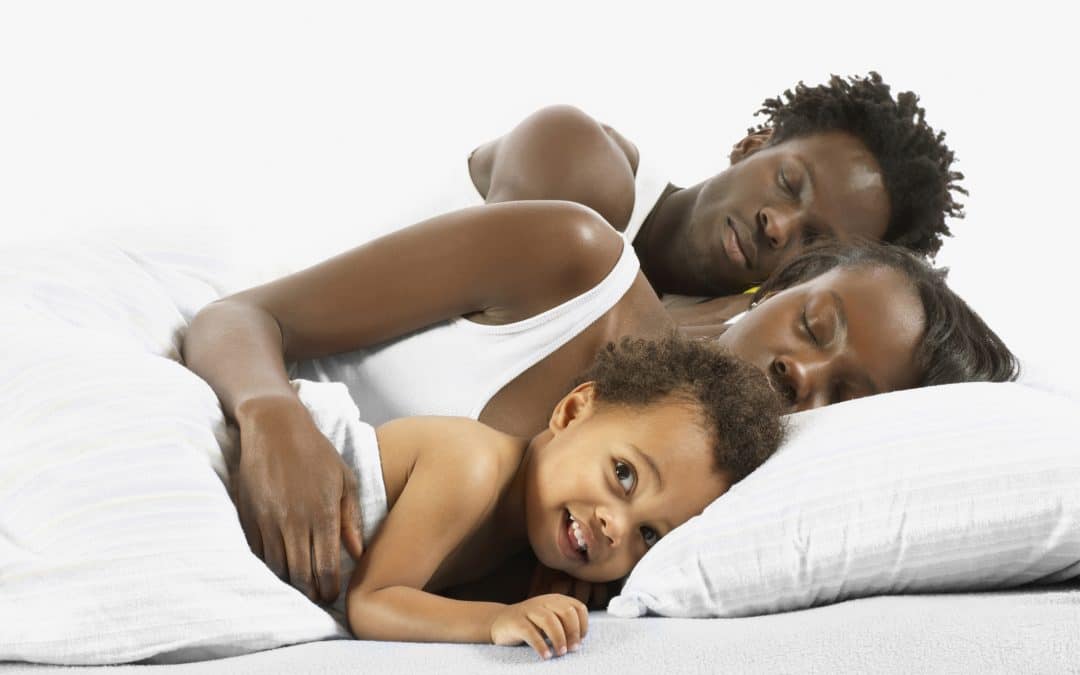
by MotherWit | Mar 24, 2017 | Birth, Parenting, Sleep, Uncategorized
As a certified infant sleep educator, the more I develop my Sleep Essentials workshops and the more I talk about this work in my community, the more apparent it is that those who work in this field need to tread with exquisite care of the Parent Soul. Nobody is at the receiving end of unsolicited advice more than new parents, and this can erode confidence and lead to stress. Taking an encouraging and nurturing approach rather than one wrought with opinion and judgement keeps our minds open to what support parents are really yearning for.
Babies are primal. Nobody has told infants that the Industrial Revolution took place and radically shifted the way human beings sleep. They didn’t get the memo that independent sleep is something that is wanted of them because of the busy daytime work schedules of their parents and the fact that we don’t live and work tribally anymore. Babies seem to want more from us around the clock than often feels sustainable to give. This is their primal nature. It has been their way for longer than we can say.
Parents are modern. Most of us are enculturated to the relatively new 9-5 work schedule the world tends to revolve around now. We were raised that way. And, as culture does shape us biologically, it makes sense that parents need to fit their sleep into a 7-9 hour period sometime between the punch out and punch in, not to mention get a little space to breathe after their day job duties, whether they are working outside of the home or working in the home doing business or tending to children).
Families are tired. Oh, are they ever tired. As a mom of four children who glued themselves desperately to my body every time I tried to extricate my arms from our embrace, I know this well. There were times I lay in bed with a toddler clamouring for my breast for the 14th time that night, wondering if I should “Ferber-ize”, worrying about how I was going to face the day on no sleep. I wanted to run away from this insane feeling dynamic that appeared terribly broken, and clearly all my fault for creating such a clingy, dependent little person (cuz mom guilt).
So where does the proverbial ‘twain meet? In this wide gap between a primal baby’s and a modern parent’s needs, where does a sane solution lie to the very real problem of family exhaustion?
There are lots of people wanting to tell you. There are many approaches, counter approaches, studies and rebuttals, experts and proselytizers wanting to shape you with their two cents. How do we discern the correct approach for our unique families? How do we get our needs met and be great parents too? What is the “right” thing to do?
Let us look at different sleep approaches. There are classic sleep training methods, which are about conditioning a baby to stop crying out for their parents when it is time to sleep. While the intention is to fulfill a biological and psychological need for more family sleep, the approaches are rooted in Behavioural Psychology. It makes very logical sense. If your baby cries for you after a certain time, you know they aren’t hungry or wet, it may just be a cuddle or nipple “habit” that motivates the “calling out” behaviours. In which case, habits can be changed. Methods are implemented over time, generally involving some to a lot of crying from your baby in protest. But for a good many parents, the few nights of howling and distress (as much as they hate it), feel worth it for the sake of more sleep for everyone, more family harmony, and a sense of shaping good sleep “manners”. Of course that sounds appealing!
The shadow side of some sleep training approaches? They are often sold as something necessary and expected to do (or else Baby will be spoiled), mired more in cultural biases than scientific evidence, create more family stress than we anticipate, and according to some studies, have a low long term efficacy rate. Despite possible misgivings at letting their babies cry-it-out, parents will often resort to anything that might work, and sleep training is logical. Not a parent in the world can be blamed for wanting to try something that could work.
We have the Attachment Parenting approach, which is rooted in Developmental Psychology, and is all about heeding that natural call for connection babies have around the clock well into early childhood. Proponents refer to the difficult biological implications of the unmet distress in a rapidly growing little brain and advocate not allowing babies to cry it out as a means of learning sleep hygiene. When looking at the workings of a baby’s brain and their reasoning capabilities (or lack thereof), it also makes perfect sense why we would NOT want to discourage attachment and the tending to a baby’s cries rapidly in the night.
The shadow side of a fully baby-led attachment approach within a culture of social isolation? Babies will, left to their own devices, very often nurse or want cuddles multiple times throughout the night well into toddlerhood. While it may be developmentally normal and security building, if the family is chronically sleep deprived, this is a remarkable burden upon relationships and health which can ultimately detract from that security. “Our culture is messed up, not our babies.” may be true from a sleep evolution perspective, but it doesn’t solve the problem of meeting the family’s crucial need for more rest to function in today’s very real world.
With all the information out there, it feels damned if we do (have babies who don’t cry for us but who may be in cortisol driven “shut down” rather than “self-soothe” mode after nights of prolonged crying it out) and damned if we don’t (having babies who cry to be rocked, cuddled, and nursed multiple times at night when we have to work the next day, maybe ‘til well past the age of two, rendering everyone frustrated, exhausted, and edgy).
What the heck do we do?!
Firstly, education and preparation while still pregnant or in the early days of parenting is one of the best ways to get ready for the reality of an infant’s sleep needs. Dissonance occurs when our expectations don’t meet our reality. So understanding how Baby’s brain functions at different levels of development is very helpful, as well as things you can do to create wonderful sleep associations for Baby right from birth. Advice to take whatever information you like, leave the rest, and do what feels right for your family is an approach you might want to look for when seeking your educational resources. Making informed choices feels empowering, and that’s a good feeling for new parents.
In this wide gap between the needs of primal babies and modern parents, MotherWit Sleep Essentials stands with Empathy (this is one of the three “E”s of our GoToSleeep Principles). Why? Because it’s vulnerable there. We know with certainty that every parenting decision made in regards to sleep is and has always been done with the utmost care and concern. This will always be assumed. People who sleep train their kid aren’t harsh or callous any more than people who are nursing 10 times per night aren’t pushovers raising an adult who will still be in their bed until college. Parents fear being all those things and yet none of them are true. We know well that constant battle between the heart and mind and witness it as an expression of your tender parental love. We have been there too.
So how can we help? By not judging you, for starters. We take a compassionate look at the sleep needs of a family holistically, checking in on things like diet, stressors, routines, levels of self-care, emotional well being and the home layout. With this information and “making changes” coaching, we create customized strategies that promote better rest which include cool things like shaping neural pathways with multi-sensory input. By respecting and caring deeply about a baby’s primal needs AND the modern parent’s needs, we have learned that balance and flexibility are the keys to unlocking sleep potential.
MotherWit Sleep Essentials provides information on the science of infant sleep and support for the art of parenting.
Sleep well, Gentle Parents.
Love,
Lesley

by MotherWit | May 9, 2016 | Uncategorized
Having worked with obstetric, postpartum, and NICU nurses over the last couple of decades, I can honestly say that aside from the birthing/new mothers, nurses are the hardest working folks in the hospital. I have developed amazing relationships with many of my local nurses over the years. Honestly, having seen many a nurse catch a quick baby with skill and compassion when a doctor didn’t get there in time, I know the whole system would fall apart without the skill and compassion of nurses.
These are my top reasons for wanting to shout out my love and appreciation to nurses this National Nursing Week.
1) Nurses tend to REALLY understand birth
Because OB nurses spend far more time with a woman in labour than other medical folks, they usually have pretty developed Spidey senses when it comes to birth, While a new medical resident may be apt to say things like, “You were 4 cm dilated only twenty minutes ago, so according to the progress of labour charts, it’s not possible you want to push now,” a nurse will rush around preparing the room for delivery, knowing that the sounds the mother is making means Baby isn’t waiting for any chart.
I have seen doctors walk into the birthing room brusquely to ask questions of the birthing mother, and witnessed the nurse put up her hand and say, “Wait, she’s having a contraction…let it end first before talking to her.” They get it.
2) Nurses set the tone
Nurses have immense power in the birthing/postpartum/NICU room. When oxytocin flows in a relaxed way, birth and motherhood often unfold more smoothly. When a nurse has respect for the birth/early parenting process and the family, no matter how the situation unfolds from a medical perspective, women often remember the FEELING of being tended to by a caring nurse. They carry that feeling in their hearts forever. Even if the doctor on call that day is busy and doesn’t take the time to connect while they do their medical tasks, the parents don’t take it personally as long as the nurse meets the basic love and connection needs of the oxytocin besotted family. Nurses have the opportunity to serve as the crucial emotional anchor,
Years after birth, reflecting upon their hospital experiences, my clients will go all melty and gooey when they speak of the nurse who was a kind presence in the room. They will call her by name and use adjectives like “angelic” and “saintly” when describing her. If nurses could only fathom the amount of love their happy patients carry for them, based on the few hours they spent together during the peak transformational experience that is the creation of a family, they would glow brightly with that beautiful sense of meaningful service.
3) Nurses are some of the hardest workers in town
Where I live, we generally do not have one on one nursing care when a woman is in labour or with her new baby. A nurse may have two or three patients with intense needs at the same time. When things get really busy in their department, you will literally see nurses jogging from room to room.
I’m always quite amazed to see the nurses, some of them far older than I am, break apart the delivery bed and set things up with remarkable strength and speed. As a doula, I know that supporting women in birth is a very physical job, and nurses do this ALL the time.
A nurse, in the midst of dramatic birthing or new parent/ baby moments, manages all her clinical tasks at the same time as listening to and supporting her frightened patient. This is no easy feat. To have head and heart engaged at the same time in the unique way nurses do, takes a level of skill I bow to.
I have also seen many nurses stay at a birth or with a tiny new patient an hour beyond their shift, because they knew their patient or little patient’s parents were attached to them. They committed to seeing them through until things settled. In the throes of labour or worry, many parents don’t notice their nurse is there after her shift has officially ended. But I notice.
4) MacGyver has nothing on nurses
If you want to be really impressed at the comfort measures that can be whipped out of thin air for in a pinch, come see a nurse in action. I learn really cool tips from nurses constantly, like how to make a super efficient heating pad out of a wet towel and a placenta bag, or an ice pack out of an examination glove, or a peanut ball out of a stirrup and a pillow. The fact that as a doula I carry very little with me in my bag besides mouthwash and a change of clothes is because nurses have taught me the art of comfort measure innovation.
Where I live, supplies can often be low. I have seen Baby’s first diaper be made out of a Chux pad and medical tape by a savvy and apologetic nurse. I have even seen nurses think to place a blanket near a sunny window (if the blanket warmer is busted) so it will be toasty and cozy for Mom and Baby after birth.
5) Nurses are Grace under fire
When a hospital staff runs smoothly as a team and everyone gets along, this is obviously the ideal situation for everyone. But I have witnessed shabby treatment of nurses sometimes by other staff members, or by those who manage them. And, let’s face it, not all patients are easy going and appreciative. Or, a nurse at any given moment may be reeling from a recent tragedy. As professionals, most nurses don’t let on to their patients that they’ve experienced something crappy. They dive into their work, and hopefully process it all later. I have sometimes walked out of a birthing room to get a coffee and beheld a nurse having a private teary moment in a stairwell.
Nursing can be a high stress, high drama job at times. It can be common for people to lose their tempers when challenged. In my experience, it is usually the nurses who do the best job of keeping their cool. They usually manage to continue their compassionate care of their patient no matter who is acting out that day.
The moments that have touched me most as a doula in regards to nurses are when their Grace comes through in the most human of ways. When a birth is clearly traumatic to a mother, or if a mother has experienced less than glorious treatment by other staff members, or if there is a tragedy, I have sometimes witnessed nurses enfold their patients in their loving arms and share tears of sorrow with them, honouring their patients with their silent acknowledgement of sad truths.
To all the nurses who work with birthing and new families, I bow to you in honour for what you do. I see you as you go about your jobs, and you have my respect and regard. May all of you be plied with wine, chocolate, massages, and love this week. I am grateful for you. I celebrate you. We at MotherWit Doula Care say THANK YOU!
Love,
Lesley

by MotherWit | May 7, 2016 | Uncategorized
Are you Pregnant? Have you given birth within the last few months? I want to ask you a question many people, your doctor included, may not think to ask: how are you REALLY doing?
Recently I spoke to a lovely pregnant mama in a doctor’s waiting room. As a doula for 22 years, my Spidey senses told me something was up. I initiated some general conversation, and after a while asked her mom-to-mom about how she was feeling . A shadow fell across her face. “Well, you know, okay I guess.”
“Yeah?” I responded, and waited. And breathed. In a small voi
ce she said, “Not so good. Everyone keeps telling me it’s just hormones, but it’s not passing. I’m unhappy. If it’s like this now, I’m afraid of what will happen when the baby comes. Can you get postpartum depression BEFORE the baby is born?”
The woman agreed to my gentle encouragement to speak to her care provider about getting a referral to a mental health professional, just for a check in. If we have blood pressure or blood sugar issues in pregnancy, we get checked out. Mental health care should be as easy and accessible to perinatal women as a childbirth ed class. It sadly isn’t, but that’s another blog.
In honour of Mental Health Week here in Canada, I want to shed light upon the fact that up to 20% of women experience anxiety and/or other mood disorders like depression in the time surrounding the birth of a baby, making mental health challenges among the most common complications of childbirth. It can happen postpartum AND in pregnancy.
When a woman experiences feelings of sadness, overwhelm, panic, intrusive thoughts, obsessive-compulsive issues, and/or anger (among others), she may be reluctant to share what’s going on for her. She can be afraid people will think she’s about to harm her baby or herself, and take the baby away from her. She often thinks her feelings are a character flaw, and that if she were a “better” person, she could pull it all together and be a “good”, happy mom.
While in some cases thoughts of self-harm/harm to the baby turn into reality, the vast majority of women will not experience this extreme. But left untreated, mental health crises can and most certainly do arise, which make life feel unmanageable. While maternal death is very rare in developed nations, suicide remains among its leading causes. Any time someone feels at risk of harming themselves or their baby, this is an EMERGENCY, and must be treated as such.
Many women feel shame for being overwhelmed or apathetic when their pregnancies/babies are healthy. There is a stigma around mental illness in general which deepens when it comes to motherhood. If there appears to be nothing to complain about, many women feel guilty about expressing their pain.
But there is good news. To quote Postpartum Support International, “You are not alone. You are not to blame. With help, you will be well.” www.postpartum.net
A doula, being a trained, experienced birth/parenting support professional, spends ample time with her client, and can often recognize some of the signs that something is amiss. She can ensure the mother gets the help she needs as soon as possible. Because the sooner the mother feels better, the more space she has to enjoy her pregnancy and her baby, which is healthier for the family long term. We want to ensure a mental health professional can intervene before a downward spiral potentially happens. Even though wait times to see one can be inappropriately long, feeling like something is done can be a relieving first step.
These are five ways doulas can help when it’s beyond “the blues”:
1) Doulas Listen
As a doula, I get to know the people in my care. I listen deeply not just for the words said, but for the feelings behind the words. I’m not afraid to ask, “Hey, how are you really feeling today?” and am comfortable not glossing the spaces over with chatter.
If the mother is receiving messages from her friends and family that her feelings will pass, that it’s “just pregnancy hormones” or “just the baby blues” even though her anxious/depressed feelings are persistent, we may be the only ones to speak up and say, “maybe this requires further investigation. Why don’t we call your midwife and you can tell her what you’ve been sharing with me?” Or, “I have the number of an amazing psychologist who specializes in perinatal mental health. Why don’t we call her right now for an appointment?”
A diagnosis made by a qualified mental health professional is important to get the ball rolling in the exploration of treatment.
2) Doulas Provide Resources
Professional doulas tend to be very community minded folks, and are well connected to the available maternity support resources. A doula can share information about the importance of the woman contacting her care provider, and then help her follow up on the doctor’s referrals to the appropriate mental health professionals. A doula herself will often have a list of psychiatrists or psychologists who specialize in perinatal anxiety and mood disorders, and can share these resources with her client.
A doula will also have resources for extra support while the mother is waiting to see her mental health professional, or is in treatment. The mom may be interested in seeing a massage therapist, nutritionist, or joining a support group for other moms going through similar things.
3) Doulas Provide Respite
Many doulas are trained/experienced in providing respite for struggling families, throughout the day or the night. Feelings of isolation and inadequacy can make mental health struggles worse, especially when they’re compounded by the exhaustion of the postpartum period.
A postpartum doula can help mothers feel like they have a handle on things while she supports feeds, keeps the mom company, and tucks her into bed where she can rest secure knowing the doula is keeping Baby happy. Or, perhaps Mom might need time with her baby and a little tidying or meal preparation done while she relaxes and bonds.
A doula always seeks to support bonding and to foster a sense of confidence and mastery in new parenthood. Occasional respite care can make all the difference when the mother is getting treatment or waiting to.
4) Doulas are on the Family’s Side
Unsolicited advice is the bane of the pregnant/new parent’s existence. Everyone wants to tell them where it’s at. Your baby should sleep through the night at birth, you should be planning an all natural delivery, you should have an epidural, you should start your baby on a bottle right away, you should breastfeed exclusively. Parents can feel like they’ll never do anything right, which can weigh heavily on a person experiencing mental health challenges.
Doulas are there to provide parents support for their choices. Period. A family’s life isn’t played to the tune of any personal doula agenda. Doulas most certainly provide parents with evidence based information, giving them more tools with which to make informed choices, however, they know that things must work for the ultimate health and well-being of the family. When parents have explored their options and made a decision that contributes to the family’s happiness (which generally contributes to Baby’s well-being too), the doula will support them.
5) Doulas Honour Mothers
In our fast paced Western culture, we are often so busy trying to do everything “right” by finding the best information, we often forget to slow down and pat ourselves on the back for growing/birthing/parenting a new little citizen as best we can. We are all already whole. It’s just that when things feel overwhelming, we forget. Your doula will not forget.
As a doula, one of the things I try to do for people is uplift them with the honour I have for them. Sometimes I will look at a mama with a new baby, tears of overwhelm streaming down her face, and I will hold her gaze for a while, seeing her in her wholeness (even when she can’t see it herself). I see her tender vulnerability as well as her wild mama strength . “I see you,” I’ll say. And I will smile at her with my whole heart to show her that I uphold her as worthy an beautiful, letting her know that I believe in her. Reflecting someone’s wholeness back to them helps them to remember who they really are.
You are not alone. This is not your fault. With help, you will be well.
With love,
Lesley

 In preparation for chemo, I decided to cut my near shoulder length mane short. I had been informed that with the type of chemo I was getting hair loss was probably not going to be much of an issue, though it could get thin, brittle, or patchy. I wasn’t interested in thin, brittle, or patchy. Before my treatment began, some of my beloved friends took me to a salon and held my hands while I succumbed to a pixie cut.
In preparation for chemo, I decided to cut my near shoulder length mane short. I had been informed that with the type of chemo I was getting hair loss was probably not going to be much of an issue, though it could get thin, brittle, or patchy. I wasn’t interested in thin, brittle, or patchy. Before my treatment began, some of my beloved friends took me to a salon and held my hands while I succumbed to a pixie cut.









